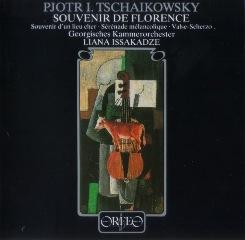Tchaikovsky - Souvenir de Florence (1992)
Tchaikovsky - Souvenir de Florence (1992)

Souvenir d'un lieu cher, Op. 42: no 1 1. Méditation 2. Valse-Scherzo for Violin and Orchestra in C major, Op. 34 3. Sérénade mélancolique for Violin and Orchestra in B minor, Op. 26 4. Souvenir d'un lieu cher, Op. 42: no 2, Scherzo 5. Souvenir d'un lieu cher, Op. 42: no 3, Mélodie Sextet for Strings in D major, Op. 70 "Souvenir de Florence" 6. Allegro con spirit 7. Adagio cantabile e con moto 8. Allegretto moderato 9. Allegro vivace Georgiesches Kammerochester Liana Issakadze - conductor & violin
Souvenir d'un lieu cher, Op. 42. This charming violin work owes its generation to the unique relationship between Tchaikovsky and his wealthy patroness, Nadezha von Meck. Effectively freeing the composer from any financial burden in life, this patronage carried with it the unusual "rider" that the two parties were never to meet. This stipulation did not, however, prevent Tchaikovsky from enjoying the amenities of Mme. von Meck's lovely Ukrainian estate when the mistress herself was away; during just such a stay in the spring of 1878 Tchaikovsky found the quiet grounds and comfortable home so much to his liking that he immediately set about commemorating the vacation by putting together the Souvenir d'un lieu cher, Op. 42 for violin and piano. The dedication of this three-movement musical truffle, the musical cousin of the Violin Concerto the composer had completed just one month earlier, is in fact made not to Mme. von Meck, but instead to the estate itself: Braïlov.
The first piece of the Souvenir, "Méditation," was actually penned while the composer was writing his Violin Concerto and originally served as that work's central movement. Tchaikovsky eventually chose to replace the "Méditation" with the now-famous "Canzonetta," but, ever loathe to waste material, he immediate recycled it as the opening number of Op. 42. It is cast in a large ABA form; the reprise of the repetitive and rather melancholy D minor opening, with its dark violin melody in the lowest register, incorporates some of the glistening triplet arabesques that fill the dolce middle portion. A little coda makes a very delicate move to D major, disappearing into the violin's high E string. In retrospect, it may have been the impassioned climaxes of the two outer sections, whose robust virtuoso outbursts and thick accompaniment are too similar to the Concerto's first movement, that led Tchaikovsky to remove the "Méditation" from the Violin Concerto.
A Scherzo in C minor follows, again outlining a compound ternary form. In the opening and closing sections -- Presto giocoso -- Tchaikovsky returns again and again to the quiet but tension-filled rising idea in running eighth notes that begins the piece; although there are some digressions, it is only when we arrive at the middle section (Con molto espressione e un poco agitato) that a real shift of gears takes place. Here, all is song, with a wave-like accompaniment in the piano right hand and an impassioned tune in the violin that pauses for breath only as the transition back to the reprise of the opening music starts to unfold.
Perhaps the strongest piece of the three, and certainly the only one to have achieved any real fame of its own, is the "Mélodie" in E flat major that concludes the group. It has a gorgeous violin melody that moves along in arch-shaped eighth note groupings, sometimes lovingly imitated by the piano, to which a very brief central portion in grazioso scherzando sixteenths provides some contrast. The little codetta at the end is as tender as music can be. --- Blair Johnston, Rovi
Tchaikovsky wrote his string sextet Souvenir de Florence (1887 - 90) in Italy, though he revised it in Russia a few years later. In this work, Tchaikovsky's last for chamber forces, the composer seems inspired more by Italy's sunny climes than by its music, for it hardly sounds Italianate; moreover, the third and fourth movements are marked by a distinctively Russian character. The work is scored for two each of violins, violas, and cellos.
The main theme of the first movement, Allegro con spirito, has a Classical leanness quite uncharacteristic for Tchaikovsky. The alternate theme is warmer, more lyrical, and wholly more typical. Throughout, the music is light and generally high-spirited. The following Adagio cantabile also has a certain lean quality, though the main theme is mellifluous and richly Romantic. The mostly unison writing in the middle section is imaginative and rather daring. The third movement, Allegretto moderato, begins quietly, ominously. Gradually a more optimistic mood partially emerges from this dark haze, though the music remains muscular, rhythmic, and busy. The middle section is bright and lively; overall, though, the movement is emotionally reserved. The Allegro vivace finale, Russian to the core, has the atmosphere of an unbridled, joyous celebration; among its typically Tchaikovskian themes are bits of Swan Lake and other familiar works. The attractive fugue demonstrates the composer's deft abilities in a form he rarely employed. --- Robert Cummings, Rovi
download: uploaded yandex 4shared mediafire solidfiles mega zalivalka filecloudio anonfiles oboom








